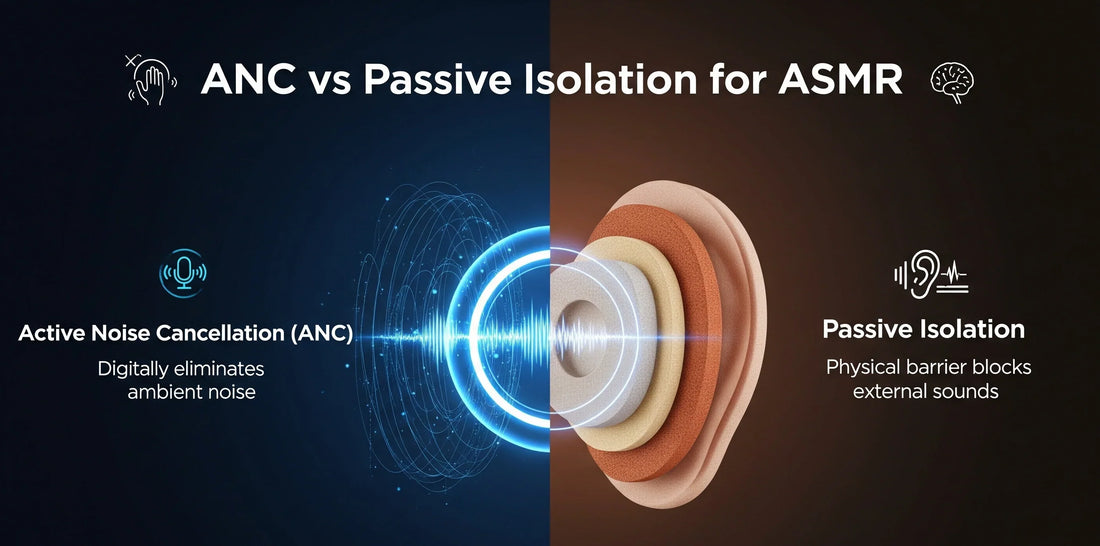
ANC vs Passive Isolation for ASMR—Which Sounds Better and Why
Share
The subtle whispers, gentle tapping, and delicate soundscapes of ASMR content demand pristine audio clarity. But when it comes to blocking out the world around you, should you rely on active noise cancellation or passive isolation? The answer isn't as straightforward as you might think—and it could dramatically affect your tingles.
The Fundamental Difference
Passive isolation works like a physical barrier. Think of it as acoustic foam wrapped around your ears—it mechanically blocks sound waves from reaching your eardrums. Quality earbuds with well-designed silicone tips can achieve impressive isolation, sometimes reducing ambient noise by 15-25 decibels across most frequencies.
Active noise cancellation, on the other hand, fights fire with fire. Tiny microphones sample environmental noise, and the system generates precisely inverted sound waves to cancel it out. It's electronic wizardry that can be remarkably effective, particularly against steady, low-frequency sounds like air conditioning hum or airplane engines.
Where ANC Struggles with ASMR
Here's where things get interesting for ASMR listeners. ANC systems excel at eliminating consistent, predictable noise patterns. But ASMR's magic often lives in the subtle details—the barely perceptible mouth sounds, the faint rustle of fabric, the whisper-quiet brushing against a microphone.
The processing required for active noise cancellation can introduce artifacts into these delicate frequency ranges. Many ANC implementations apply compression or filtering that, while imperceptible during music playback, can muddy the crystalline clarity that makes ASMR effective. You might notice that soft consonants lose their crispness or that the spatial positioning of binaural recordings becomes less defined.
There's also the curious phenomenon of ANC "pressure." Some listeners report a subtle sensation of increased air pressure when ANC is active—not painful, but noticeable enough to potentially interfere with the relaxation that ASMR seeks to provide.
The Passive Advantage
Passive isolation doesn't discriminate. It reduces all external noise equally without introducing any electronic processing into your audio signal. What you hear is exactly what the ASMR creator intended—no compression artifacts, no phase shifting, no algorithmic interpretation of the soundscape.
Modern earbuds with properly fitted ear tips can achieve remarkable isolation. Memory foam tips, in particular, can create an almost hermetic seal that rivals many ANC systems for overall noise reduction. The key difference is that passive isolation preserves the original audio signal's integrity completely.
Testing the Difference
You can conduct your own comparison with surprising precision. Play a familiar ASMR track—ideally one with whispered speech and gentle triggering sounds. Listen first with ANC enabled, paying attention to the clarity of sibilant sounds (s, sh, th) and the depth of any binaural effects.
Then switch to passive isolation only. You might need to increase the volume slightly to compensate for less aggressive noise reduction, but focus on whether the audio feels more "present" or immediate. Many listeners notice that passive isolation preserves a sense of intimacy that ANC can sometimes diminish.
For an even more revealing test, try listening to ASMR content recorded with minimal post-processing—raw binaural recordings often showcase the difference most dramatically.
When ANC Makes Sense
This isn't to say that ANC is inferior for ASMR across the board. If you're listening in consistently noisy environments—commuting, in an office with HVAC noise, or near constant traffic—ANC can provide a cleaner baseline that makes soft ASMR content audible without cranking the volume to potentially harmful levels.
Modern ANC implementations have also improved significantly. Premium earbuds now offer transparency modes and adjustable ANC intensity, letting you fine-tune the balance between noise reduction and audio purity.
The Hybrid Approach
Many experienced ASMR listeners develop a situational strategy. In quiet environments—your bedroom, a library, a peaceful evening at home—passive isolation often delivers the purest experience. When environmental noise becomes intrusive, a light touch of ANC can restore the listening environment without heavily processing the audio signal.
Some earbuds even allow you to customize ANC profiles, creating a gentler setting specifically for ASMR that provides noise reduction without aggressive signal processing.
The Bottom Line
For the ultimate ASMR experience, passive isolation typically preserves more of the content's original character and subtle details. The mechanical simplicity of a good seal maintains audio fidelity while still providing substantial noise reduction.
However, ANC has its place when environmental noise would otherwise force you to turn volumes up to uncomfortable levels or when consistent background noise makes it impossible to hear quiet ASMR content clearly.
The best approach might be having both options available—earbuds that offer excellent passive isolation through quality tips and the ability to engage ANC when circumstances demand it. This gives you the flexibility to choose the right tool for your environment and the specific ASMR content you're enjoying.
Ultimately, your ears and your tingles are the final judges. What matters most is which approach lets you fully immerse yourself in the carefully crafted soundscapes that make ASMR so uniquely effective.
